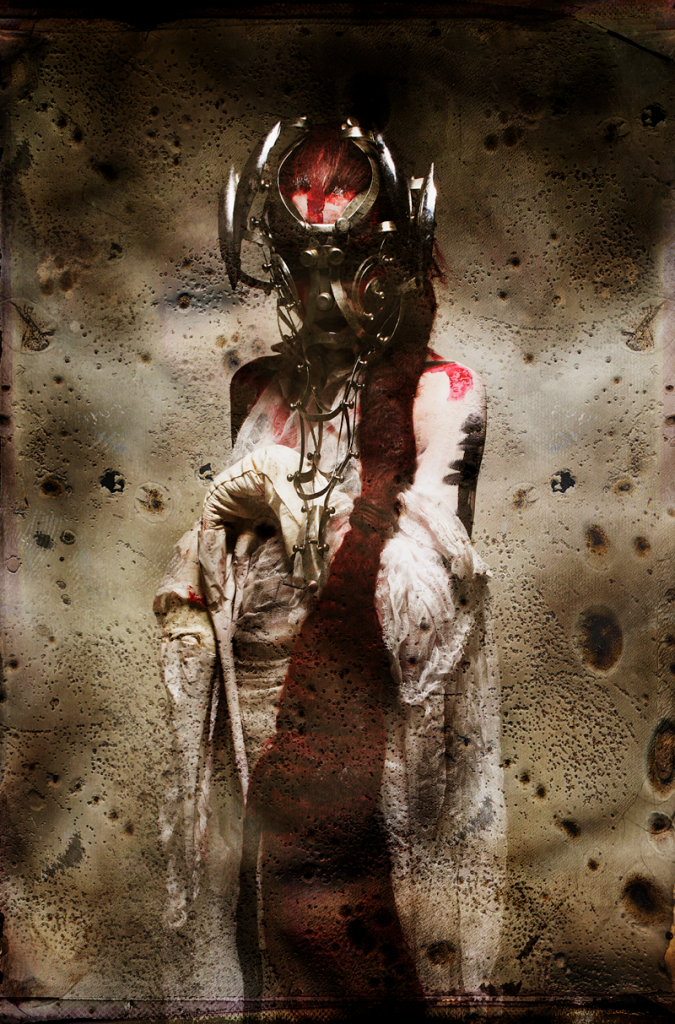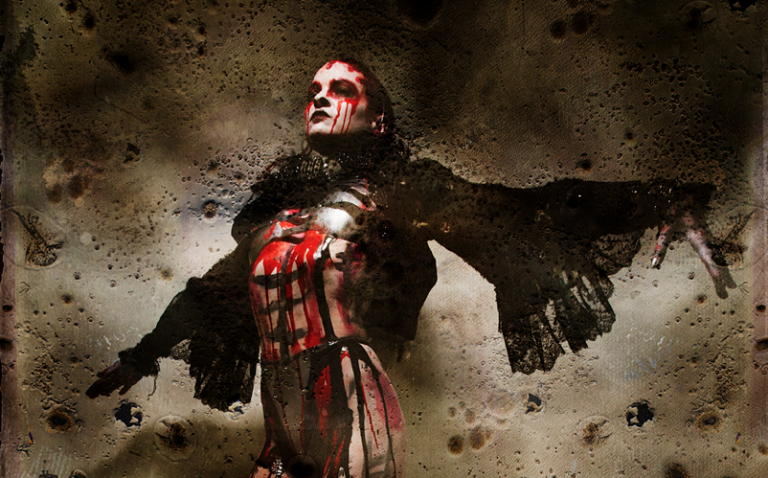
Few artists have the ability to represent their art on and off stage, and Johanna Constantine is one of those artists. When you see her live show, she stays in your mind, both mysterious and fascinating. As a pioneer of the New York underground performance, she is one of the most important artists of the contemporary art scene— dance, installations, and live performances are some of the ways you can witness her talent. Her decadent and dark images have always been Johanna’s trademark having elements like blood, metal and paint recurrent in her work.
Johanna has presented her work in some of the biggest cultural venues around the world and has collaborated with various internationally renowned figures. We had the opportunity to speak with her about her work, inspiration, desires, her talented collaborators and her new phase of activism.
What does being on stage mean to you?
When I picture in my mind, what I want to present on stage, it’s always an image I feel that is very old; I have pantheons of creatures and ghosts on my mind. They all have special purposes to fulfill and feelings and struggles, like people. I look at them as visions of me, but they are also something else. I like to see them as things coming through me for the audience. I said in the “Turning” film that I feel more honest presenting myself in the make-ups than out. It is more informative as to how I am deeply feeling.
Your performances have an aura of decadence and vitality, as if they were only a thread of life. For whom do you do it? For life? For death? Both?
There is a lot of sadness and struggle in the images. I want to bind them to their sister feelings of heeling and strength. Hope is the most important word for me. In the beginning, all of my dances were very violent things. As I got older, this began to change. I have always worked very closely with Antony (as a founding member of Blacklips). I was purposefully the more aggressive, protective element. I would be the first to enter, creating a defended area to express more gentle emotions. When I perform with Antony now, we still carry that order, but I feel Antony is creating a space for me to express the quieter things. Perhaps this started as I began to compose dances for friends who had died. I still do this, sometimes even secretly within my work.
What does nudity represent to you?
I am often asked if I will be performing nude, which is strange because I have never done so! I have always made the choice to cover the breasts and genitals, as I am not addressing human sexuality in my work. While nudity itself certainly doesn’t always represent this, I think for many spectators it will bring it in as an element. For me, nudity would be very distracting from my goals. I actually have many fans who are still children. I would never do a performance that could not be shown!
There are elements in your work that speak for themselves— like flesh, blood, ornaments— but why the metallic pieces?
I am sure with all the blood and metal, it can be difficult at first to see the hope element. They are often very apocalyptic images, things struggling to survive in a hostile world. I prefer to perform dances in groups of three, representing connected imagery. One of my favorite groups was “Things that Survive in a Void.” This was a single person surviving upon the land, a beautiful pregnant insect and a ghost mourning the dead. I wanted to portray a sense of survival and hope after a cataclysm. I feel it is very important to address the environmental fears that weigh so heavily upon us at this time. They are often so difficult to voice, but should be appreciated. Many of my metal pieces are created by a great artist from Barcelona named Manuel Alberron. I have known Manuel for too long to say, and he is a great inspiration to me. His work brings the alien to life. I design the fabric forms, extensions and make-up. Our work is so well aligned, I have never asked him to change or build anything for me he would not naturally do. To this date, all the pieces are by me or Manuel.


We know that many of your outfits are Purevile, the brand of the talented Wren Britton, do you design any of your wardrobe?
I want my costumes to be completely transformative. It is very challenging to find materials that look organic to the body, not like clothes. I want to create new forms that are really walking through the world, not a representation. This led me to use a lot of metal, bone, wood and wire— to put on the under make-up takes 2 or 3 hours. I use a lot of body extensions I build with anything that has the shape I want. I then have to do special workouts with weights to be able to lift the pieces! I do wear Wren Britton’s Purevile pieces almost every time; they are so beautiful and surreal. I consider them art pieces as much as clothes. I wouldn’t be surprised to see some of them in stage performances soon!
Who are your influences and inspiration?
I have very important people in my life. Antony is my main collaborator, as we have been doing our work together since we were teenagers! Musically, I have done the most choreography to William Basinski, as well as live performances. I also work as much as possible with video choreographer and filmmaker Charles Atlas; I have made many personal breakthroughs working with Charles. Our favorite thing is to do live performances with Charles mixing images of the live piece on screens as the dance happens. We recently did this during his residency at the Tate Modern in London. We have done projects together since the early 90’s and many more to come I hope!
We know you’re good behind the consoles, what can we expect to hear when you are mixing?
I still participate heavily in the New York night scene; I like the hyper-reality of the clubs. It is for me, an idealized world of freedom and expression. I have been DJing in New York since the early 90’s. I have seen many inspiring performances in clubs. My work has never fit in with them so well, as it is slower and of different emotion. Musically, I am all over it! At the moment I am DJing a club project called Dorian Gray with my friend Wren Britton and the Zand Collective. The idea is to have decadent experimental music from many eras and to go for maximum visual presentations. I and many others build our own outfits. It is important to us that it is free and anyone can go. We encourage people to be as wild as possible. All appearances, ages and sexualities are represented. Though I am known more for experimental electronic music (I do mixes of this for my dance as well). At the moment I am playing a lot of punk, as that is what I grew up with! I do secretly compose some special pieces for clubs once a year or so, out of respect to them.
Have you tried to enter the world of writing?
At the moment, I have been spending a lot of time writing and doing political work. My priority is the launch of a movement called Future Feminism. It is a collaborative project involving Antony, Bianca and Sierra of Cocorosie, Kembra Pfahler and myself. We are proposing feminism as a larger global solution for problems we see besetting the planet and the human beings upon it. This seems to be all one thing to me. A love of people and the wish for all of us to thrive on this beautiful world is what ties all of my actions together. I embrace the darkness, and seek to find the light within it.
She is the mystery made flesh. Being at her mere presence is intimidating. Her big green eyes look eager and consume everything they see, as if they found another meaning unknown to us. Her lips sealed contain silences that become words with each of her movements. Her performance symbolizes life and death. Some people consider death a celebration, but what makes Johanna, is living poetry from death itself.
TEXT: BJORZH ZNCHZ


